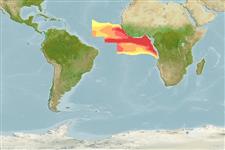>
Lophiiformes (Anglerfishes) >
Oneirodidae (Dreamers)
Etymology: Dolopichthys: Greek, 'dolops' or 'dolopos' = ambusher + Greek, 'ichthys' = fish (meaning "a fish that attacks by surprise") (Ref. 86949).
Environment: milieu / climate zone / depth range / distribution range
Ökologie
seewasser bathypelagisch; tiefenbereich 0 - 700 m (Ref. 26282). Deep-water
Eastern Central Atlantic.
Size / Gewicht / Alter
Maturity: Lm ? range ? - ? cm
Max length : 2.2 cm TL Männchen/unbestimmt; (Ref. 10524)
Kurzbeschreibung
Morphologie | Morphometrie
Rückenflossenweichstrahlen (insgesamt): 7; Afterflossenweichstrahlen: 6. Characterized by having two tapering filaments on dorsal midline of escal bulb, each darkly pigmented except for distal one-half to one fourth of length ; posterior filament twice as long as anterior filament, 25-26.7% of illicium length; 2 simple, short, unpigmented tapering appendages placed bilaterally on dorsal surface of escal bulb posterior to long tapering filaments; swollen basal part of compressed posterior escal appendage without pigment; presence of connecting membrane between anterior and posterior filaments of posterior escal appendage; teeth on lower jaw 35-39; teeth on vomer 2; dorsal fin rays 7; anal fin rays 6; pectoral fin rays 19-20 (Ref. 86949).
Mesopelagic.
Life cycle and mating behavior
Geschlechtsreife | Fortpflanzung | Ablaichen | Eier | Fecundity | Larven
Bertelsen, E., 1990. Oneirodidae. p. 498-507. In J.C. Quero, J.C. Hureau, C. Karrer, A. Post, and L. Saldanha (eds.) Check-list of the fishes of the eastern tropical Atlantic (CLOFETA). JNICT, Lisbon; SEI, Paris; and UNESCO, Paris. Vol. 1. (Ref. 10524)
IUCN Rote Liste Status (Ref. 130435)
Bedrohung für Menschen
Harmless
Nutzung durch Menschen
Mehr Information
NamenSynonymeMetabolismusRäuberÖkotoxikologieFortpflanzungGeschlechtsreifeAblaichenSpawning aggregationFecundityEierEientwicklung
Alter/GrößeWachstumLänge-GewichtLänge-LängeLängenhäufigkeitenMorphometrieMorphologieLarvenLarven Pop.Dyn.RekrutierungDichteBRUVS
ReferenzenAquakulturAquakultur ProfilZuchtlinienGenetikElectrophoresesVererbbarkeitKrankheitenVerarbeitungNutrientsMass conversion
PartnerBilderStamps, Coins Misc.LauteCiguateraGeschwindigkeitSchwimmstilKiemenoberflächeOtolithsGehirngrößeSehfähigkeit
Tools
Zusatzinformationen
Download XML
Internet Quellen
Estimates based on models
Preferred temperature (Ref.
123201): 11 - 16.8, mean 14.1 °C (based on 18 cells).
Phylogenetic diversity index (Ref.
82804): PD
50 = 0.5078 [Uniqueness, from 0.5 = low to 2.0 = high].
Bayesian length-weight: a=0.01995 (0.00906 - 0.04395), b=3.01 (2.83 - 3.19), in cm total length, based on all LWR estimates for this body shape (Ref.
93245).
Trophic level (Ref.
69278): 3.0 ±0.4 se; based on size and trophs of closest relatives
Widerstandsfähigkeit (Ref.
120179): hoch, Verdopplung der Population dauert weniger als 15 Monate. (Preliminary K or Fecundity.).
Fishing Vulnerability (Ref.
59153): Low vulnerability (10 of 100).
